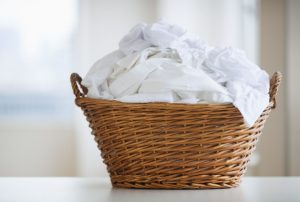Home cleaning experts share their best hacks and tips for tidying up your kitchen, bathroom and more.
A clean home can seem like an unattainable goal, especially when life gets busy and schedules are complicated. It’s easy to feel overwhelmed and before you know it, dust, dirt and grime build-up and over time lead to an unattractive and unhealthy environment for you and your family.
Instead of ignoring the problem, take control. Nancy Bock, Senior Vice President, Education & Meetings for the American Cleaning Institute says technology and cleaning products make cleaning your home easier than it was five or 10 years ago. “Everything from housecleaning apps on your phone that will help you clean and keep track of your cleaning schedule, to the actual instruments that replace the old bucket of water and a mop,” she explains.
Be honest about how much time you have to clean, how clean you want your home, and the most important spaces in your home you want clean. This helps you devise a strategy to get the job done. “You can design a schedule and it can look fantastic on paper and that’s all well and good, but if you’re not reasonable about how much time you can spend cleaning that schedule can backfire,” cautions cleaning expert and YouTube host Melissa Maker of Clean My Space.
And remember the more organized you are the better chance you have to stay clean, says Debra Johnson, a home cleaning expert with Merry Maids. “Have a cleaning caddy for your different cleaners and use a microfiber cloth that pulls the dust and soil into the cloth and also releases it when you rinse it,” says Johnson. Keep the caddy in a designated spot, and use a different colored cloth for each task. Avoid overusing cloths or using too much product, which leads to smearing and streaking and increases your cleaning time.
The good news: you don’t need the most expensive cleaning products or tools to successfully clean your home. Common household items used in creative ways can often save money and get the job done. But a word of caution: even “natural” products can sometimes cause a reaction on different finishes and furniture, or pose problems for those who suffer from airborne or skin allergies. Test new products in a small, inconspicuous area to make sure they work for you and your home.
Here are key spaces in the home and the best expert hacks and tips on how to clean them:
Kitchen
If you want to clean your microwave without chemicals, Johnson says take a cup of water and put it inside your microwave and heat for two minutes. This creates steam inside, so you can use a clean microfiber cloth to wipe the appliance down and remove any residue or stuck-on bits of food.
Dishwashers have evolved over the years, and Bock stresses the importance of reading your manual. “Homeowners often treat a new dishwasher like they last one they purchased, but the technologies have changed,” she says. For example: newer models often have sprayer arms that can be removed and regularly wiped clean, which helps the efficiency and longevity of the appliance.
Mystery refrigerator smells can be frustrating. Maker says first establish the cause of the odor. Don’t allow plates of leftovers or spilled milk to build up over time. Wipe infected areas clean as soon as possible and use a deodorizer to keep future smells from overtaking your refrigerator. While baking soda is the most popular, Maker says you can also use activated charcoal, an open cup of unused coffee grounds or a cut lemon (flesh side up). Johnson says cotton balls with a couple drops of vanilla extract placed in the back of your refrigerator is another option. Whatever you use, remember to change the deodorizer frequently for best results.
Bathroom
Since the constant presence of water in a bathroom can lead to mildew and mold, Bock says paying attention to air circulation creates a healthier environment and allows you to spend less time cleaning. “Sometimes people don’t turn on the exhaust fan, open the window or always keep the door closed,” she points out. “You need air circulation, which is also important when you’re using cleaning products.”
Mineral deposits from water can lead to a clogged or dirty shower head. To clean it, both Johnson and Maker suggest using a plastic food storage bag filled with white vinegar that you tie around your shower head with an elastic band. Allow the bag to sit overnight, and then turn the shower on in the morning to rinse away build up.
Maker says the easiest way to keep your shower clean from soap scum is to use a squeegee each time you shower, to wipe your shower walls down before you step out. Once you’re out, use the squeegee to wipe the tub to eliminate as much moisture and water as possible.
Hairspray or toothpaste can create stubborn splatters on your bathroom mirror. To remove them, Makers says use a dab of rubbing alcohol on a cotton ball or soft cloth to gently wipe away the offending marks.
Bedroom
Dirty sheets can give your bedroom a stuffy smell. Maker says if you suffer from allergies, wash your bed sheets once a week. For non-allergy sufferers, washing sheets once every other week should help eliminate odors and keep your bedroom smelling fresher.
While people think their sheets, they often forget about their bed skirt. “They’re a magnet for dust, pet hair and human hair,” says Bock. “You need to remove and launder them every three weeks. And if you store items under your bed, pull those items out when you sweep or vacuum because they’re a magnet for dust.”
Family Room
Framed photos are notorious dust collectors. Bock says when you spray cleaner directly on framed photos, the cleaner can sometimes bleed behind the frame to the matting and damage photos. Instead, spray your cleaner onto a soft cloth instead of the frame itself, so you can control the amount of cleaner and avoid the bleeding problem.
Family rooms can often become the cluttered drop zone for the house. To keep on top of things, Maker says she and her husband have a rule: when they leave the family room, they always take something in their hands. This allows the couple to keep books, dishes, magazines and mail from overtaking the space.
Living Room
Sometimes you don’t clean what you don’t see, points out Bock. Food crumbs build up between chair and sofa cushions and attract rodents and pests. If you can’t stop family members from munching on the sofa, check and remove cushions often and use a damp cloth or hand-held vacuum to remove the crumbs.
Spilled food and drinks create stains on area rugs. Johnson says the quicker you remove the stain, the better it will be. “When blotting the stain with a damp microfiber cloth, use a fan to circulate the air to remove the dampness after you clean the stain,” she advises.
If your living room or another space has a ceiling fan, use a sock on your hand to securely capture the dust. “If you haven’t cleaned it for a while, spray the sock with a bit of furniture polish to make sure you can capture all the dust,” suggests Bock.
Home Office
Clean your computer screens and keyboards by combining one part rubbing alcohol with one part distilled water (water with no minerals) in a spray bottle, says Maker. Lightly spray a soft microfiber cloth with the mixture and gently but quickly buff dry to remove dust and bacteria.
Bills, mail and job-related paperwork can create a messy home office, so it pays to have a paper shredder. “By having that one simple tool in your office, you will make managing that room much easier,” says Maker.
Laundry Room

A build-up of fabric softener can dirty the bottom of your iron and stain clothes. To clean your iron, Maker says make a paste of equal parts baking soda and water and then apply the paste to a soft cloth. Using a circular motion, gently clean the build-up (being careful to avoid the holes in the iron where the steam comes out) and rinse with a damp cloth.
If you have a front load washer, moisture can build up in the inside lip and cause funky odors or mildew. Each time you use the washer, gently lift up the lip and wipe with a clean, soft cloth to remove as much moisture and water as possible. Maker says she leaves her washer door open for a bit after each load, to allow air to circulate and remove moisture.
Copyright to the original publisher Good HGTV.
Sponsored by The econcierge Delivering the usual exceptionally. Get in touch with us at [email protected]










